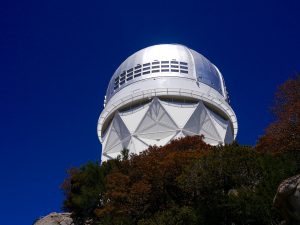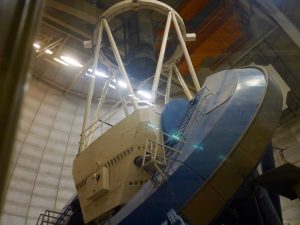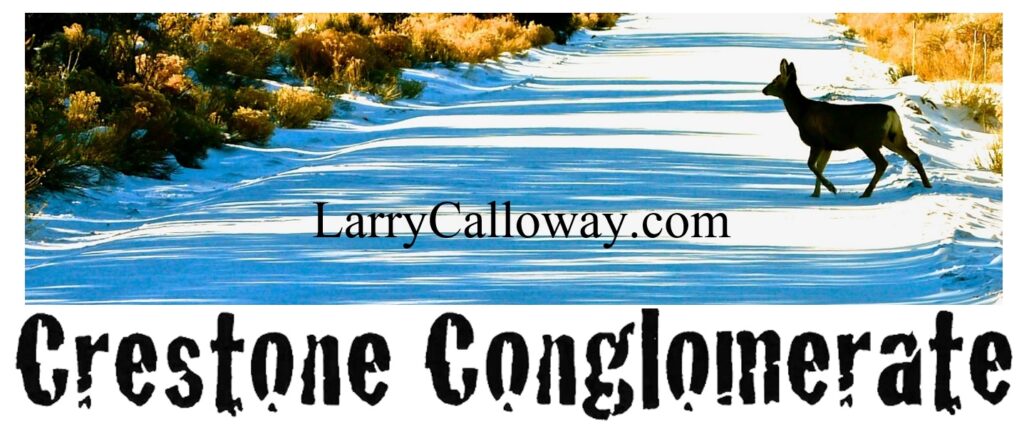
By LARRY JOSEPH CALLOWAY (C)
Southern Arizona is known for some spectacular views of . . . the heavens. Kitt Peak, which we visited, has 25 big astronomical telescopes, most of them owned by universities. Other land-based optical observatories (to use the technical term accommodating the space age) are scattered on other Arizona peaks.
Before ascending to higher views we attended a demonstration of a small (about $15,000) scope in a dome at the Butterfield RV Resort And Observatory in Benson, AZ. The volunteer, who called himself an “astro-nerd” as opposed to a professional astronomer, punched up Orion, the Pleiades, Jupiter with its four large moons, and the relatively blinding one attached to us.
This experience probably is what motivated us to drive Freddy the RV up Kitt Peak about two weeks later. The Ford 450 had no problem climbing the serpentine two-lane road that gains about 5,000 vertical feet in 12 miles to the cool 6,880 crest dotted with white domes against a far desert backdrop.

We took a tour in which a retired astronomer walked us up to the floor of the biggest scope at the highest point (on a clear day its dome can be seen from Tucson). Called the Mayall Telescope, it was the first project after the government acquired from the Tohono O’oodham tribe a perpetual lease to the mountain top (now resented by some of its members) in the post-Sputnik frenzy of 1958.
After seeing the huge tracking and focussing machine, Pat wondered, “Where is the little man looking through an eyepiece?” (Mayall is like a camera, it makes photos.) She was wise enough not to ask the ancient astronomer in his floppy hat.
I was not so wise, asking him, “Why are so many discoveries made by amateurs with small telescopes?” He answered, brusquely, that those comets, asteroids, etc., were basically “uninteresting.” The professionals are doing science.
This dominant scope on Kitt Peak is going to be completely redone next year into a Dark Energy

Spectroscopic Instrument, funded by the U.S. Department of Energy (Don’t tell Rick Perry!) It’s mission will be to create a 3-D map of most of the sky seen from the northern hemisphere. Not only will it tell the distance from us of millions of galaxies and quasars. It also will tell the speed at which they are accelerating away. (Yes, we were told, the big boom gets faster like a rock dropping in gravity.) Its field of view, 3,000 times greater than that of the Hubble telescope (relatively small and orbiting) will be an angle of “8 square degrees”. . . . (I will leave it here. I thought degrees were round.)
I love the heavens. But I am still working on my amateur status. And this Southwest RV tour I brought along a small scope I have battled with for 30 years. Whereas the Mayall scope at Kitt peak has a 4-meter main mirror (158 inches diameter), my mirror is about 6 inches. But inspired by southern Arizona’s unified (apolitical) interest in star gazing, I assembled my scope and tried focusing. The problem, as always, was the little finder scope had a loose adjustment and was at a neck-breaking angle.
Before giving up I remembered the astro-nerd. He said go see Jack Lopez at Stellar Vision in Tucson. With a little GPS help we found the place nearly under a freeway bridge in a row of businesses that included a martial arts gym. Scrawled across a bolted garage door in black spray-can letters was “Stellar Vision.”
I opened the heavy fortified door and entered a dark room full of objects that resolved themselves as telescopes — a hoard of wonderful, colorful, large and small Meades and Celestrons and many others, even a Questar (my dream as a kid). Frank Lopez came out of the back. He is a close listener, a long-haired bespectacled man with. . . focus. I explained my problem. He understood.
I brought in my scope. He went into the back while I envied the beautiful scattered inventory. He emerged with a right-angle finder, removed the old straight one, installed the new one, holding hex wrenches like a surgeon. Cost of parts and labor: less than dinner at Red Lobster (named for a galaxy?)
That night I grew unhappy with the fix, so next morning I took the scope back. Jack Lopez said he had been thinking about my problem and his solution and he had a better idea. “A red dot,” he said.
It might as well have been something uttered between graduate students on Kitt Peak. Like, black hole or blue, brown, yellow or white dwarf? He said it was a sight developed for hunters. He put it on the scope, and it works! I cant say how, but its like an open gun sight (sword to plowshare) with a red dot at the center of a sighting ring.
When I had asked Jack Lopez what the new bill was. He responded, “No charge. I am here to solve problems, not make money.” Coming from a man whose business is helping people raise their eyes to the heavens, it was kinda religious. . . .
At the Mayall visitor door an engraved plaque quotes Kepler, the mathematician who proved the orbits of planets at the 17th Century rise of science. It is religious in a way that the articulation of his unfortunate contemporary, Galileo, was not:
“We don’t ask for what purpose the birds do sing, for them song is pleasure since they were created for singing. Similarly we ought not ask why the human mind troubles to fathom the secrets of the heavens. The diversity of the phenomena of Nature is so great, and the treasures hidden in the heavens so rich, precisely in order that the human mind shall never be lacking in fresh nourishment.”
